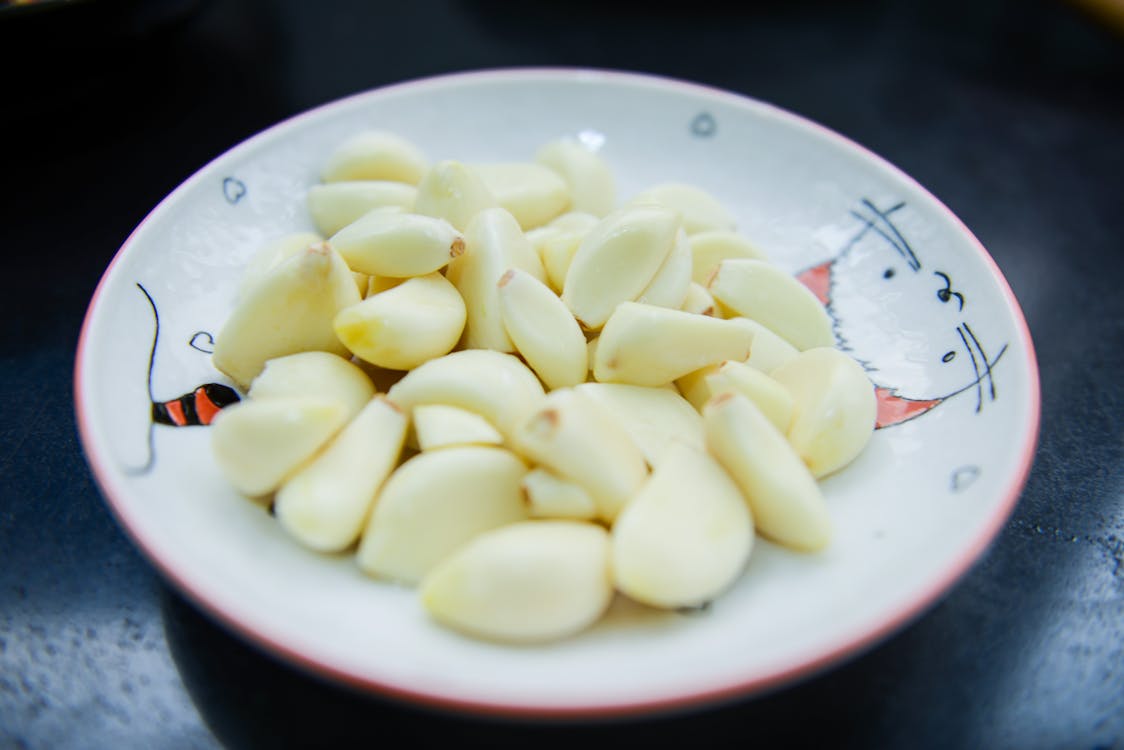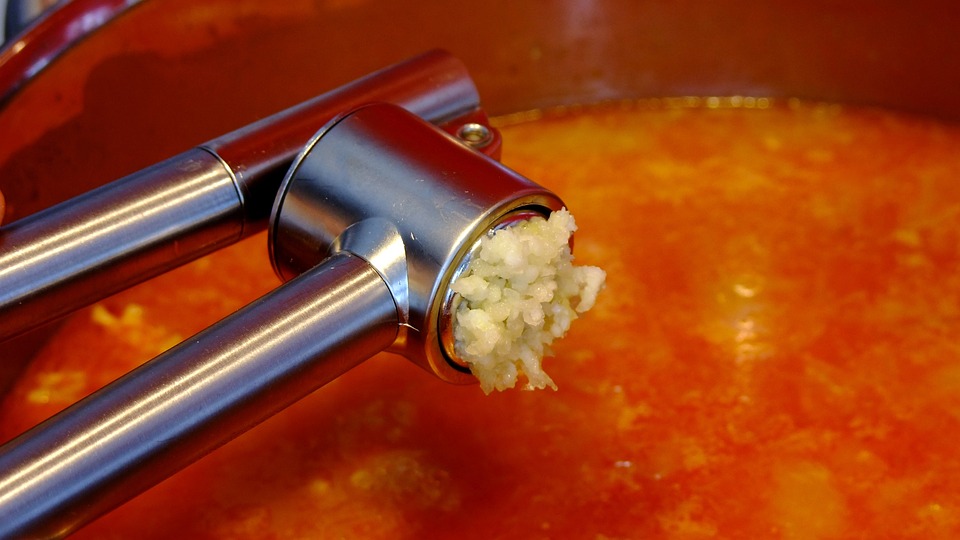One clove of garlic equals approximately 1 teaspoon of chopped garlic or 1/2 teaspoon of minced garlic.

WHAT IS GARLIC AND GARLIC CLOVE
Garlic is a plant of Allium or onion family basically used to flavor the food. It is off-white colored, has a flowered shape. Garlic is available in every season all around the world and can easily be cultivated in mild climates. China produces 80% of the world’s supply of garlic. Garlic is added to many dishes because of its aroma and also used to garnish the gravy or platter. It is a key ingredient in several dishes.
A whole garlic bulb is referred to as “head or knob” of garlic. Each separable and skin wrapped part of the garlic bulb is known as garlic clove. Each garlic is divided into 10 to 20 cloves; each of them is covered in purple white thin layered skin. Practically every dish we make has one or two cloves.
WAYS TO PEEL A GARLIC CLOVE
- Peeling it by knife; after separating each clove, cut the head of clove, Place the flat side of the knife on the clove and push down firmly, peel away the skin of clove by your hands.
- By using water; soak the cloves in cold water for 5 to 10 minutes, remove it and they will easily peeled off.
- Putting clove in microwave; microwave garlic clove for 10 to 15 seconds, then cut away its loose remaining skin.
- Placing garlic in a bowl; put whole garlic in steel bowl and cover it with another one, shake it vigorously, open the bowl and remove the waste.
STORAGE OF GARLIC
Moisture and light cause mold to grow, these are the worst enemies of garlic. Some storage methods are written below which can prevent it from spoiling.
- Domestically, storing garlic in warm – above 18 °C (64 °F) – dry, dark place with plenty of air circulation, keep it fresh and dormant for long time.
- Peeled cloves can be put in to the vinegar in refrigerator. Vinegar helps to prevent it from the spoiling. But avoid putting whole garlic inside the refrigerator; this may cause sprouting in no more than a few days.
- Commercially, garlic is stored at 0 °C or 32 °F, in a dry, low-humidity environment.
- Garlic is often kept in oil to produce delicious flavored oil. This oil can be used in vegetables, pasta, bread and many other recipes.
- Acidification of garlic also minimizes the growth of bacteria.
- Dehydration keeps it fresh for long time. Dried garlic can be stored easily at room temperature in air tight container for many months.
- Garlic will keep longer if the tops remain attached. Keeping the garlic covered in its skin will prevent it from spoilage.

CLOVE OF GARLIC EQUALS
1 clove of garlic equals approximately 1 teaspoon of chopped garlic, 1/2 teaspoon of minced garlic and 1/8th teaspoon of garlic powder.
3 teaspoons make one tablespoon. So if we are using tablespoon then three cloves of garlic equals to one tablespoon, 1 ½ tablespoon of minced form of garlic and 3/8 tablespoon of powdered garlic. As a comparison, tablespoon is larger than teaspoon. One teaspoon is around 5 mL while one tablespoon is equal to 15 mL.
Here the question arises, what actually chopped, minced and powered garlic are?
CHOPPED GARLIC
Chopped garlic is actually very small pieces of garlic. It is formed by horizontal cutting or chopping of cloves individually by the help of knife.
MINCED GARLIC
Minced garlic is similar to the paste of garlic. Several ways can be used to mince whole garlic clove. Garlic can be minced through “grater” by using the same method to grate carrots and cheese. Another tool used to mince garlic is “garlic press”. Peeled clove is put into garlic press and by pressing it firmly, minced form of garlic will forced out from its small holes.

POWDERED GARLIC
Garlic powder is very different from minced and chopped garlic. It is ground, dehydrated garlic. Garlic powder is formed when dehydrated garlic clove is grinded in the grinder or by crushing it hardly by hands.
DRIED GARLIC FLAKES
Garlic flakes are small, dehydrated pieces of garlic. They are obviously not garlic powder. Dried garlic flakes are commonly used in curries, soup stew and other gravies. Dried garlic is actually a great way to preserve garlic.
SUMMARY: 1 clove of garlic equals to how many teaspoons depends on the form of garlic. If garlic is finely chopped so it will take one teaspoon, if it is in a minced form so ½ teaspoon will be used and this goes on.
BENEFITS OF GARLIC
Garlic is highly beneficial. Garlic is a great source of vitamin C, vitamin B6 (pyridoxine) and magnesium. It also consist calcium, potassium, iron and some other minerals which are essential for health of well beings. In ancient era, garlic was used as a medicine due to the presence of sulfur, diallyl disulfide and s-allyl cysteine.
Some significant benefits of garlic are:
- Garlic is most commonly used to cure common cold. Drinking garlic tea helps to prevent flu, cough, common cold and make the immune system strong.
- High blood pressure or hypertension is very important to be maintained. Garlic aims to cure high blood pressure.
- Garlic contains proportionate amount of Allicin, which is an anti-oxidant agent. This helps to lower cholesterol level which is one of the major causes of stroke and heart attack.
- Massaging minced garlic juice on scalp and washing it after half an hour make hair smooth, thick and prevent hair loss.
- Garlic with its antioxidant property protects against cell damage. This may lower the risk of Alzheimer disease and dementia.
- Garlic protects the skin from free radicles and has anti-aging property. It also provides relief against fungal infections.
- Garlic has amazing purifying property which removes all the impurity from blood, making skin acne free and glowing.
- Garlic tea is also used to lose weight.
- Garlic helps to prevent the production of cancer cells.
But if garlic is used in excess amount it may cause many disorders too.
SIDE EFFECTS OF GARLIC
If garlic is over used it may cause:
- Garlic in excess amount causes irritation in gastro intestinal track (GIT).
- Garlic leads to bad breath, if consumed in excess. The main reason is the sulfur compound present in it.
- Garlic, especially fresh garlic, might increase the risk of bleeding.
- Allicin in garlic can cause liver toxicity if taken in large quantities.
- Taking garlic so much can lower the blood pressure.
- Garlic may cause some allergic reactions i.e. asthma attacks, skin rashes and many more.
- Consuming garlic on an empty stomach can cause diarrhea.
- Consuming garlic for a prolonged time may lead to excessive sweating.
FREQUENTLY ASKED QUESTION (FAQS)
Is garlic a vegetable?
Botanically, garlic is considered as a vegetable. A vegetable is any edible part of an herbaceous plant, such as the roots, leaves, stems, and bulbs. And, garlic is a root vegetable.
Can too much garlic cause gas?
It contains sulfur which is gas foaming compound. So the garlic in excess quantity cause stomach cramps, bloats and gases.
What neutralizes garlic in the stomach?
The acid in lemon juice neutralizes alliinase, an enzyme produced by crushing garlic that causes bad odor and stomach cramps.
CONCLUSION
One clove of garlic equals approximately 1 teaspoon of chopped garlic or 1/2 teaspoon of minced garlic, it depends on the form of garlic, whether it is chopped, powdered, dried or minced. Garlic is available in every season; it is famous because of its flavoring property and aroma.
Garlic must be stored in warm, dry place with passage of air to keep it fresh for long time. Every element has its own advantages and disadvantages, so does garlic has. So stop excess use of garlic and take full advantage of it.
RELATED ARTICLES
How to Make Spaghetti?
Minced Garlic to Clove